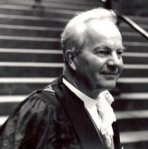I was reading around in preparation for teaching on Christology last week and ended up spending time in T.F.  Torrance’s collected lectures published as Incarnation:The Person and Life of Christ (Paternoster). Every time I come back to Torrance I am reminded just how significant a theologian he was. His work is shot through with careful attention to the Biblical text, passion for the Gospel, and fluid clarity so characteristic of a seasoned lecturer.
Torrance’s collected lectures published as Incarnation:The Person and Life of Christ (Paternoster). Every time I come back to Torrance I am reminded just how significant a theologian he was. His work is shot through with careful attention to the Biblical text, passion for the Gospel, and fluid clarity so characteristic of a seasoned lecturer.
Take the following passage on Christ’s assumption of fallen flesh:
When the Word became flesh, he became all that we are in our opposition to god in our bondage under law – that is the amazing act of gracious condescension in the incarnation, that God the Son should assume our flesh, should enter a human existence under divine judgement, enter in the situation where the psalmist cried Eli, Eli lama sabachthani, so that the Word or Son of God himself gave out the same cry when overwhelmed with the divine judgement upon our flesh (61).
Torrance took the post of Chair of Christian Dogmatics at New College, University of Edinburgh in 1952. The chair had previously been held by Hugh Ross Mackintosh, Torrance’s earlier instructor who had encouraged him to read and study the theology of Karl Barth. Barth would be Torrance’s longtime occupation, first studying with him at Basel in 1937 and later playing a significant role in the editing of Barth’s Kirchliche Dogmatik.
Incarnation comprises Torrance’s lectures on Christology and Soteriology delivered in his classes on Christian dogmatics at New College during the years 1952-1978. Torrance had gathered his notes during the years 2001 and 2002, but before they could be edited for publication he suffered the stroke that brough both his scholarly career to an end and the process of bringing these lectures to print. Thankfully for the editorial work of Robert Walker we, together with Torrance’s students who heard them first hand, can benefit from his immense learning, insight, and strength of faith.
The volume makes at least two significant contributions (both of whichWalker notes as well in the introduction). First, it offers the most systematic and complete presentation of Torrance’s thought available. While he had hoped to do so, he had never produced a dogmatics. Second, this provides a fine introduction to Torrance’s theology that will surely open the way for readers to mine the depths of earlier publications. If you have read any of Torrance’s other works, then you know that for all its liveliness and depth, it is not light going; it is challenging – immensely rewarding to be sure – but challenging. One hopes these published lectures would give readers encouragement to engage Torrance’s other works, which undoubtedly will reward.
Because, if they are anything like me, readers of Torrance’s lectures may just find a sense of home, a resonance with the Gospel long-proclaimed in the Church but far too rarely heard so clearly-resounding in the academy:
[H]ere in the full humanity of Jesus, as it is joined eternally to his deity in incarnation and atonement, man’s destiny as man is actually assured and restored to its place in God from which it has fallen; man’s wrong has been set aside in and with the judgement accomplished upon the humanity of Christ, and now in his humanity our new right humanity has been established before God (186).
Amen indeed.
No comments:
Post a Comment